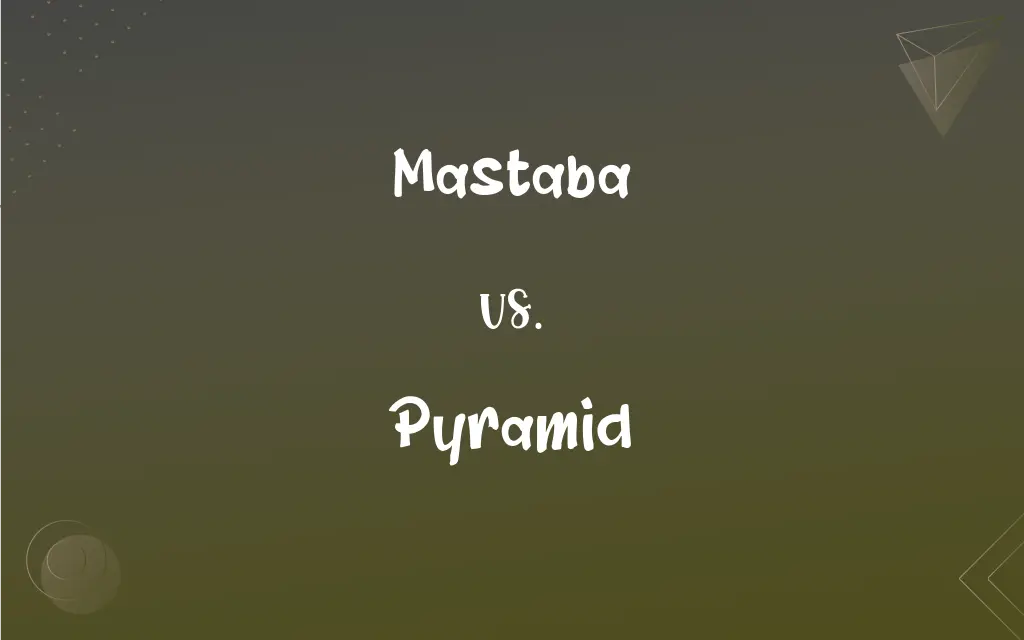Mastaba vs. Pyramid: What's the Difference?
Edited by Aimie Carlson || By Janet White || Published on April 23, 2024
Mastaba is an ancient Egyptian tomb with a flat roof and sloping sides, made of mudbrick or stone. Pyramid is a monumental structure with a square base and four triangular sides converging to a point at the top.

Key Differences
A mastaba is an early form of Egyptian tomb, characterized by its rectangular shape, flat roof, and outward-sloping sides. Pyramids, evolved from mastabas, are monumental structures with a square base and four triangular sides that converge to a point.
Mastabas were primarily constructed from mudbrick or stone and were used during the early periods of Egyptian civilization as tombs for the elite. Pyramids, built later, were primarily constructed from limestone or granite and served as elaborate tombs for pharaohs and nobility.
The internal structure of a mastaba typically includes a chapel and a burial chamber, often underground. In contrast, pyramids, especially those from the Old Kingdom, feature complex inner structures with multiple chambers, corridors, and sometimes elaborate tomb decorations.
Architecturally, mastabas represent a simpler form of tomb construction, whereas pyramids are more complex and grandiose, reflecting advancements in both design and engineering in ancient Egypt.
The transition from mastabas to pyramids marks a significant evolution in ancient Egyptian burial practices and religious beliefs, with pyramids symbolizing a more sophisticated approach to the afterlife and the divine status of the pharaohs.
ADVERTISEMENT
Comparison Chart
Shape
Rectangular with flat roof and sloping sides
Square base with four triangular sides converging to a point
Construction Material
Mudbrick or stone
Primarily limestone or granite
Purpose
Tombs for elite and nobility
Tombs for pharaohs and high-ranking officials
Architectural Complexity
Simpler, early tomb design
More complex and monumental
Internal Structure
Typically a chapel and underground burial chamber
Multiple chambers, corridors, and decorative elements
ADVERTISEMENT
Mastaba and Pyramid Definitions
Mastaba
An ancient Egyptian tomb with a rectangular shape and sloping sides.
The archaeologists discovered an intricately decorated mastaba belonging to a high-ranking official.
Pyramid
Architecturally complex structures with internal chambers and corridors.
The internal labyrinth of corridors in the pyramid revealed the sophistication of Ancient Egyptian engineering.
Mastaba
A precursor to the pyramids, used as tombs for the elite.
Many mastabas were found surrounding the pyramids, indicating their use by the elite.
Pyramid
An ancient monumental structure with a square base and four triangular sides.
The Great Pyramid of Giza is one of the most iconic examples of ancient pyramid construction.
Mastaba
Simple tomb structure with underground burial chambers.
The mastaba's subterranean chambers held valuable artifacts from the Old Kingdom.
Pyramid
Represents the pinnacle of ancient Egyptian tomb construction.
The construction of pyramids marked the height of ancient Egyptian architectural achievements.
Mastaba
Flat-roofed, early Egyptian tomb built from mudbrick or stone.
The mastaba in the excavation site revealed insights into early Egyptian burial practices.
Pyramid
Egyptian tombs built from limestone or granite, symbolizing divine pharaohs.
The pyramids were built to honor and house the remains of pharaohs, seen as gods.
Mastaba
Represents an early phase in the evolution of Egyptian tomb architecture.
Studying mastabas helps understand the transition to pyramid construction.
Pyramid
Symbolizes advancements in ancient Egyptian religious beliefs and practices.
Pyramids reflected the evolving beliefs in the afterlife and the celestial journey of the pharaohs.
Mastaba
An ancient Egyptian tomb with a rectangular base, sloping sides, and a flat roof.
Pyramid
A solid figure with a polygonal base and triangular faces that meet at a common point.
Mastaba
A wide stone bench built into the wall of a house, shop etc. in the Middle East.
Pyramid
Something shaped like this polyhedron.
Mastaba
(architecture) A rectangular structure with a flat top and slightly sloping sides, built during Ancient Egyptian times above tombs that were situated on flat land. Mastabas were made of wood, mud bricks, stone, or a combination of these materials. Some are solid structures, while others can contain one or more rooms, sometimes decorated with paintings or inscriptions.
The pyramids at Giza are flanked by large cemeteries containing hundreds of mastabas.
Mastaba
In Mohammedan countries, a fixed seat, common in dwellings and in public places.
Mastaba
A type of tomb, of the time of the Memphite dynasties, comprising an oblong structure with sloping sides (sometimes containing a decorated chamber, sometimes of solid masonry), and connected with a mummy chamber in the rock beneath.
Mastaba
An ancient Egyptian mudbrick tomb with a rectangular base and sloping sides and flat roof;
The Egyptian pyramids developed from the mastaba
FAQs
What is a pyramid?
A monumental structure with a square base and four triangular sides converging to a point.
Who were buried in mastabas?
Elite and nobility in early Egyptian civilization.
Do mastabas have any symbolic meaning?
They symbolize early Egyptian beliefs in the afterlife.
How complex is the structure of a mastaba?
Relatively simple with a chapel and burial chamber.
What are the internal features of a pyramid?
Multiple chambers, corridors, and often elaborate decorations.
What materials were used to build mastabas?
Typically mudbrick or stone.
What is a mastaba?
An early form of Egyptian tomb with a flat roof and sloping sides.
How old are the oldest mastabas?
They date back to the early periods of Egyptian civilization, around 3000 BCE.
Were pyramids only built for pharaohs?
Primarily for pharaohs, but some high-ranking officials also had pyramids.
What materials were used for pyramids?
Mainly limestone or granite.
What do pyramids symbolize in ancient Egypt?
The divine status of pharaohs and advanced religious beliefs.
Are mastabas still built today?
No, they were specific to ancient Egyptian culture.
What is the largest pyramid in Egypt?
The Great Pyramid of Giza.
Were mastabas a precursor to pyramids?
Yes, they represent an earlier phase in tomb architecture.
Are there mastabas near pyramids?
Yes, many were built around pyramid complexes.
How were pyramids constructed?
Through advanced engineering and labor, using large stone blocks.
Is there artwork inside mastabas?
Yes, many contain intricate decorations and carvings.
How long did it take to build a pyramid?
It varied, but the Great Pyramid took about 20 years to construct.
Can visitors enter pyramids?
Some pyramids are open to visitors, with restrictions for preservation.
What's the significance of pyramid shape?
It's believed to represent the rays of the sun and aid the pharaoh's ascent to heaven.
About Author
Written by
Janet WhiteJanet White has been an esteemed writer and blogger for Difference Wiki. Holding a Master's degree in Science and Medical Journalism from the prestigious Boston University, she has consistently demonstrated her expertise and passion for her field. When she's not immersed in her work, Janet relishes her time exercising, delving into a good book, and cherishing moments with friends and family.
Edited by
Aimie CarlsonAimie Carlson, holding a master's degree in English literature, is a fervent English language enthusiast. She lends her writing talents to Difference Wiki, a prominent website that specializes in comparisons, offering readers insightful analyses that both captivate and inform.































































